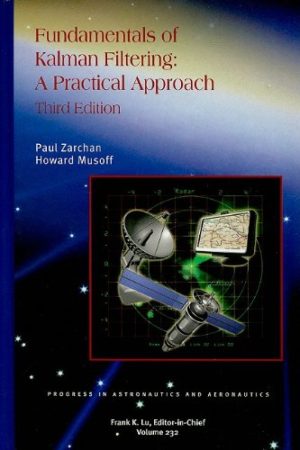Description
Fundamentals of Kalman Filtering: A Practical Approach, 3rd Edition
| Author | : Paul Zarchan |
| Year | : 2009 |
| BookType | : Hardcover |
| Pages | : 852 |
| ISBN | : 9781600867187 |
Language– English
Fundamentals of Kalman Filtering: A Practical Approach, 3rd Edition by Paul Zarchan.
This is a practical guide to building Kalman filters that shows how the filtering equations can be applied to real-life problems. Numerous examples are presented in detail, showing the many ways in which Kalman filters can be designed. Computer code written in FORTRAN, MATLAB[registered], and True BASIC accompanies all of the examples so that the interested reader can verify concepts and explore issues beyond the scope of the text. In certain instances, the authors intentionally introduce mistakes to the initial filter designs to show the reader what happens when the filter is not working properly. The text carefully sets up a problem before the Kalman filter is actually formulated, to give the reader an intuitive feel for the problem being addressed. Because real problems are seldom presented as differential equations, and usually do not have unique solutions, the authors illustrate several different filtering approaches. Readers will gain experience in software and performance tradeoffs for determining the best filtering approach. The material that has been added to this edition is in response to questions and feedback from readers. The third edition has three new chapters on unusual topics related to Kalman filtering and other filtering techniques based on the method of least squares. Chapter 17 presents a type of filter known as the fixed or finite memory filter, which only remembers a finite number of measurements from the past. Chapter 18 shows how the chain rule from calculus can be used for filter initialization or to avoid filtering altogether. A realistic three-dimensional GPS example is used to illustrate the chain-rule method for filter initialization. Finally, Chapter 19 shows how a bank of linear sine-wave Kalman filters, each one tuned to a different sine-wave frequency, can be used to estimate the actual frequency of noisy sinusoidal measurements and obtain estimates of the states of the sine wave when the measurement noise is low.
About the Author
Paul Zarchan has a BSEE degree from the City College of New York and an MSEE degree from Columbia University. He has more than 30 years’ experience in the missile guidance and control field and has worked as Principal Engineer for Raytheon, served as Senior Research Engineer with the Israeli Ministry of Defense and is currently a Principal Member of the Technical Staff at the Charles Stark Draper Laboratory. <P>Dr. Howard Musoff has a BSEE degree from the City College of New York, an MSEE degree from Northeastern University, and an Sc.D.degree from MIT. He is a Principal Member of the Technical Staff at the Charles Stark Draper Laboratory, were he has been employed for more than 40 years. Among other tasks, he designs Kalman filters for applications in the filed of inertial navigation. Dr. Musoff is also a co-holder of two patents in that field.












Reviews
There are no reviews yet.